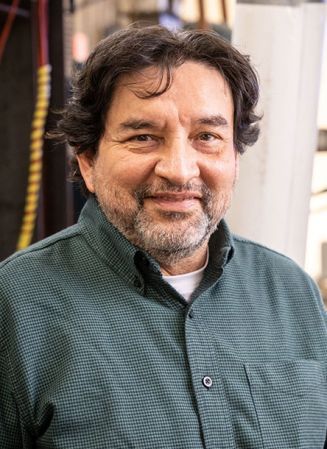
Lehigh University engineering researchers working with a Pennsylvania-based technology company have recently entered the second phase in the development of a novel ion-exchange method to capture carbon dioxide that could potentially run on waste heat produced by industry.
The method pairs a filter (more specifically, a capture sorbent, a material that absorbs CO2 gas) with an electrochemical cell that breaks down sodium sulfate into sodium hydroxide and sulfuric acid solutions. These weak base and weak acid solutions work together to capture and subsequently purify the captured CO2.
Eventually, the technology will be packaged into a unit about the size of a shipping container.
“Air flows through the filter, which captures the CO2,” says Arup SenGupta, a professor of both chemical and biomolecular engineering and civil and environmental engineering and lead researcher on the project. “When the filter capacity is exhausted, the conversion process initiated by the electrochemical cell produces pure CO2 that you can then pressurize and put in underground storage, or liquify and sell on the market.”
Additionally, he says, the sodium hydroxide and sulfuric acid recombine in the process to form sodium sulfate. “So you can keep using the salt to sequester CO2, in theory, forever,” he says.
The U.S. Department of Energy is continuing to fund the project, which is a collaboration between Lehigh, including its Energy Research Center (led by Carlos Romero, mechanical engineering and mechanics research full professor), and Advanced Cooling Technologies (Lancaster, PA), most recently through a Phase II Small Business Technology Transfer (STTR) award. ACT researches and manufactures thermal management products for a range of industries. A system prototype will be built at ACT and deployed for testing under an operational environment at Lehigh's ERC.
“The unique aspect here is that we don’t use any heat to extract the CO2 and regenerate the sorbent,” says Josh Charles ’11G ’19 PhD, a lead research and development engineer at ACT and a Lehigh mechanical engineering alumnus. “The process is driven by electricity, and the conversion is done at room temperature.”
Charles says current capture systems need to be heated up to at least 100 degrees Celsius, and sometimes much higher, which creates its own emissions that also need to be offset. Or, the unit needs to be located near a significant geothermal heat source, like those in Iceland.
“We still have high energy loads, but they’re electrical, and we think we can offset those pretty well with renewable sources,” he says.
The process can also be powered by heat, he says, but at much lower temperatures than in typical capture systems. So the units could potentially be run by waste heat produced by industry.
In Phase I, the team proved their method was comparable to others currently in use. In Phase II, they will focus on both scaling the process and improving its efficiency. They’ll also explore using novel new filter materials SenGupta has developed for another carbon capture project in which CO2 is converted into sodium bicarbonate (aka baking soda) that can be released harmlessly into the ocean.
“Those materials can capture three times as much CO2 per cycle,” says Charles. “So they could significantly improve our design by allowing us to reduce the overall size of the system.”
The team’s ultimate vision is for a modular system capable of operating almost anywhere with each modular unit capturing up to 1,000 tons of CO2 per year. Future users, the researchers say, will likely be private firms operating them as investment properties to tap into the carbon market, or large corporations looking to directly offset their emissions. The simplicity of the system could even make them accessible to schools and community organizations.
There’s still much work to be done, but both Charles and SenGupta believe the potential of the project presents a huge opportunity to make a meaningful impact on the climate crisis. And, says SenGupta, their research will go into the public domain for all to access.
“It doesn’t matter where you live,” he says, “the U.S., Europe, or the tiniest country in Africa, you should have access to the information that will enhance the public good.”
Story by Christine Fennessy



